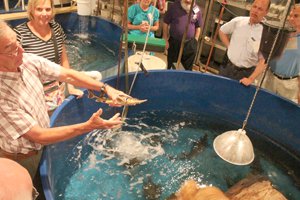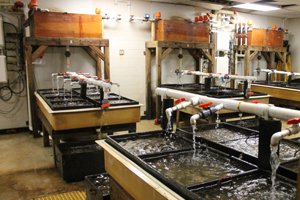Spanning rivers streams creeks runs lakes and reservoirs the COG Region’s water quality is of prime importance to local jurisdictions. Not only does water quality involve local policy and work in our own region the water in Metropolitan Washington contributes to the health of an entire aquatic ecosystem and national treasure: Chesapeake Bay.
At the COG Leadership Retreat in July board members and staff ventured out to the University of Maryland Center for Environmental Science (UMCES)  Horn Point Laboratory to hear from experts on our region’s waters and environment. Research being conducted at Horn Point is as varied as the challenges facing the Chesapeake watershed. Horn Point scientists spoke to water quality habitat preservation and climate change modeling and led the COG Board members through the facility’s oyster hatchery sturgeon restoration and physical oceanography labs.
Horn Point Laboratory to hear from experts on our region’s waters and environment. Research being conducted at Horn Point is as varied as the challenges facing the Chesapeake watershed. Horn Point scientists spoke to water quality habitat preservation and climate change modeling and led the COG Board members through the facility’s oyster hatchery sturgeon restoration and physical oceanography labs.
Participants saw how low levels of dissolved oxygen in the Bay and our rivers are the result of both warm water temperatures and nutrients that are discharged into our waterways. Warming of nutrient rich waters allows algae to grow which decreases sunlight penetration into the water stunts growth of submerged aquatic vegetation and depletes oxygen when the algae die and decompose. The algae can also cause human and aquatic health problems as we recently saw from the algal bloom in the Toledo Ohio area and see in yearly blooms in the Chesapeake Bay. The algae can act as a toxin and lower dissolved oxygen in the water makes it harder for native fish and plant life to grow reducing water quality and biodiversity.
COG retreat participants saw how oysters are bellwethers of water quality and key to improving the Bay. The famed Chesapeake Oyster has greatly waned in population due to decades of unchecked pollution and overharvesting. This population had formerly filtered the Bay water en masse and provided lavish feasts for Americans (and the world via exports) for hundreds of years. Scientists at the Horn Point facility estimated that oysters are at one-half of one percent of their peak numbers. Horn Point scientists are now working to regrow this population. As both market value for oysters and the recognition of the value of water quality has increased efforts to increase oyster populations have begun and are anchored for the State of Maryland at Horn Point. Participants toured the oyster hatchery seeing the process of oyster egg fertilization to spat to oysters ready to be set in the Bay.
Participants also  saw Short Nosed Sturgeon which used to populate Chesapeake Bay in such abundance that colonial settlers counted on this now endangered species as a reliable food source. Sturgeon are bottom feeders that are an integral part of a healthy Bay but are susceptible to waters too high in pollutants and low in dissolved oxygen. Horn Point scientists are developing new methods to breed sturgeon in their facility as a first step to restoring the fish throughout the Bay.
saw Short Nosed Sturgeon which used to populate Chesapeake Bay in such abundance that colonial settlers counted on this now endangered species as a reliable food source. Sturgeon are bottom feeders that are an integral part of a healthy Bay but are susceptible to waters too high in pollutants and low in dissolved oxygen. Horn Point scientists are developing new methods to breed sturgeon in their facility as a first step to restoring the fish throughout the Bay.
Participants also learned the intricate connection between climate change water quality pollution and risk to our infrastructure. Understanding our water is especially important to our region in an age of so-called 100 year storms occurring every few years. As recently as this year the historic port areas along the District of Columbia waterfront and Alexandria VA have flooded.
Retreat participants also heard from climate modelers at Horn Point. These scientists were able to accurately predict the effects of Hurricane Isabel on flood water in Alexandria and have developed yet more advanced modeling for our region since. Only behind Southern Florida and Louisiana the Chesapeake Bay region is among the most vulnerable in the country to the effects of rising sea levels. Higher waters and more frequent storms call for better preparation. Planners at COG are preparing for climate change and have spearheaded resiliency efforts for storms and flood waters alike.
Partnerships made between COG and UMCES Horn Point during this retreat will extend the knowledge network that our board policy committees and staff have access to when taking actions that protect our regional waters and environment.